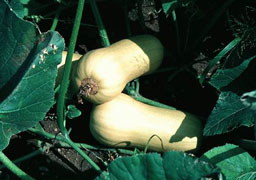


Home
Flowers &
Indoor Plants
Fruits & Nuts
Ornamentals
Vegetables
Special Topics
Resources
Glossary

 |
What about it? Squash comes from a family of vine crops that include cucumbers, watermelons, pumpkins, and melons. Squash is native to the Americas, and was grown by the Native Americans along with its other two sister" crops, beans and corn. There are many different squash varieties. Zucchini, patty pan squash, crookneck, and straightneck yellow squash are summer varieties. Hubbards, buttercups, and butternut are winter crops. What is it used for?Squashes are becoming increasingly popular. The skin of some squashes can be eaten and the skin of others should not be eaten. Summer squashes have tender rinds whereas winter squashes have hardened rinds. However, the flesh of the winter squash is sweeter than the flesh of the summer squash. Where does it grow? How do we grow it? Rich soil and warm weather are the preferred growing conditions for squash. Squashes need about an inch of water each week. Mulching might be necessary to keep down weeds and hold in moisture. Many gardeners grow squash on black plastic. What are its primary problems? Squashes are commonly attacked by squash bugs and squash vine borers. Squashes are also susceptible to powdery mildew, wilts and viruses. Mosaic viruses are a problem as well. How do we propagate it? Plant summer squash seeds in groups of four, 1 inch deep and 2 feet apart. Plant the winter squash in sets of 6-8, 1 inch deep on a small hill or a mound. Make the mounds 6 feet apart. How do we harvest and store it? Summer squashes should be picked when tender, probably within one week of flowering. Yellow squash and zucchini are best if picked when they are 6-8 inches long and 2 inches wide. Winter squashes should be harvested before the first frost but after the vines have yellowed and died.
© Copyright, Department of Horticulture, Cornell University. |


